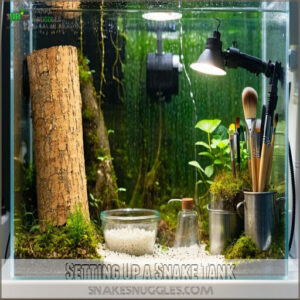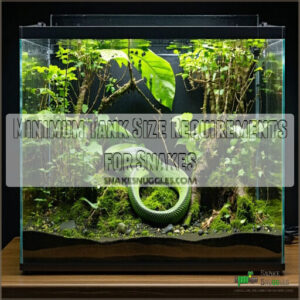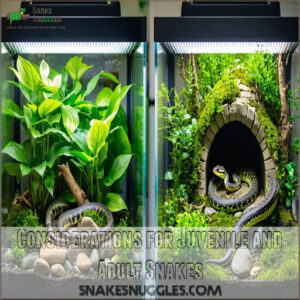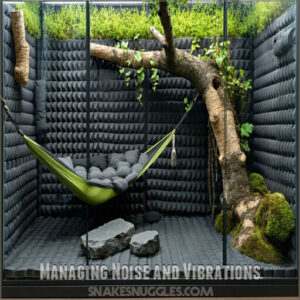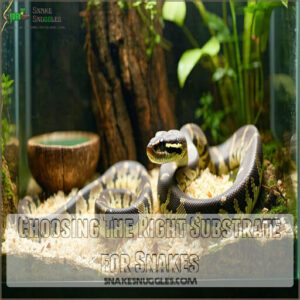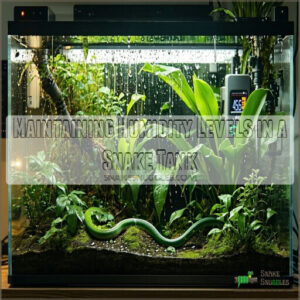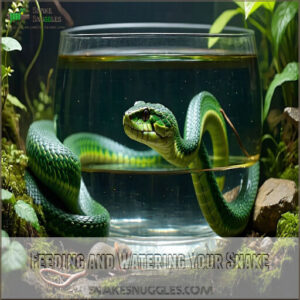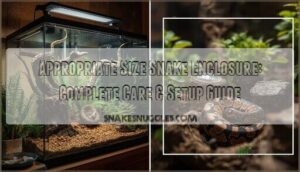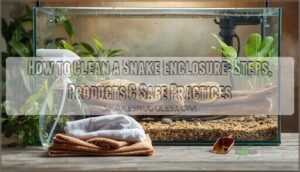This site is supported by our readers. We may earn a commission, at no cost to you, if you purchase through links.
 Setting up your snake’s home isn’t rocket science, but you’ll want to get it right.
Setting up your snake’s home isn’t rocket science, but you’ll want to get it right.
Your snake tank setup guide starts with size – the enclosure should be about two-thirds of your snake’s length.
You’ll need the basics: a secure glass or acrylic tank, proper heating (think heat mat with thermostat), humidity control, and hiding spots.
Like humans, snakes need their personal space!
Add a water bowl, suitable substrate like coconut fiber, and some decor to break up sight lines.
Getting these fundamentals right means a happy, healthy snake who’ll be your scaly buddy for years to come.
Table Of Contents
- Key Takeaways
- Setting Up a Snake Tank
- Choosing The Right Snake Tank Size
- Creating a Snake-Friendly Environment
- Heating and Lighting Options for Snakes
- Maintaining Humidity Levels in a Snake Tank
- Providing Enrichment for Your Snake
- Essential Temperature and Lighting Requirements
- Safety and Security Measures for Snake Tanks
- Feeding and Watering Your Snake
- Ongoing Care and Maintenance for Your Snake Tank
- Frequently Asked Questions (FAQs)
- How do you set up a snake tank?
- How do you choose a snake tank?
- How do I set up a snake enclosure?
- What do you need for a snake tank?
- How do you keep a snake in a tank?
- How long should a snake tank be?
- How should a snake tank be set up?
- What do you put in the bottom of a snake tank?
- What is needed in a snake enclosure?
- How to care for a snake for beginners?
- Conclusion
Key Takeaways
- You’ll need to choose a tank that’s at least two-thirds of your snake’s length, and set it up with proper heating, lighting, and ventilation to create a comfortable environment for your pet.
- Don’t forget to add substrate, decorations, and hiding spots to your snake’s tank, as these will help reduce stress and promote natural behaviors, making your snake feel secure and happy.
- You’ll want to maintain a temperature gradient of 75-95°F, with a humidity level of 40-50%, and provide fresh water and a balanced diet to keep your snake healthy and thriving.
- Regular cleaning and maintenance are crucial to keeping your snake’s tank clean and hygienic, so make sure to spot clean daily, change the water and substrate as needed, and perform a deep clean every month to prevent bacterial growth and keep your pet safe and happy.
Setting Up a Snake Tank
You’re about to set up a snake tank, and it’s key to get it right.
You’ll need to choose the perfect snake, select a suitable terrarium or tank, and gather all the necessary accessories to create a comfortable and safe environment for your new pet.
Choosing The Right Snake
You’re looking for a pet snake. Consider these beginner-friendly species:
- Spotted Pythons
- Children’s Pythons
- Corn Snakes
They’re known for gentle personalities and easy care.
Assess pet suitability, handling techniques, and breed selection based on temperament and your experience. Choose a snake species that fits your lifestyle.
Selecting a Terrarium or Tank
You’ve chosen your snake, now pick a terrarium. Consider Tank Materials like glass or custom-built acrylic for a secure, escape-proof home.
Glass Tanks are popular for visibility, while Aquarium Options offer more space. Proper tank sizing is important for snake health, so follow this snake tank setup guide for specifics.
Follow this terrarium setup guide for a secure snake tank setup, and explore Enclosure Types and Terrarium Sizes.
Essential Snake Enclosure Accessories
Now that you’ve picked your tank, let’s deck it out! Your snake needs comfy hiding spots, one on each side. A heavy water bowl prevents spills.
Thermometers are key for tracking temps. A heat mat and thermostat keep things cozy. Proper snake enclosure setup is essential for their well-being.
Don’t forget climbing branches, and a substrate like coconut fiber.
- Water Bowls
- Hiding Spots
- Heat Mats
- Thermostats
- Hygrometers
Choosing The Right Snake Tank Size
You’re getting ready to set up your snake’s new home, and choosing the right tank size is important.
You’ll want to pick a tank that’s at least 2/3 the size of your snake’s body, so it can stretch out comfortably and move around freely.
Measuring Your Snake’s Length and Girth
To set up your snake tank, measure your snake’s length and girth.
Use a soft tape, and measure when calm. Record monthly to track growth, ensuring scale accuracy and considering body proportions for your snake tank setup guide.
| Snake Length | Girth Measurement |
|---|---|
| 3 feet | 6 inches |
| 4 feet | 8 inches |
| 5 feet | 10 inches |
| 6 feet | 12 inches |
| 7 feet | 14 inches |
This will help you create an accurate snake tank setup guide, with the right proportions, and ensure a healthy environment, by tracking scale accuracy.
Minimum Tank Size Requirements for Snakes
Determine your snake’s tank size by considering its length. A 4-foot snake needs a 32-inch enclosure.
Different snake tank types offer various benefits, such as glass, PVC, or wood.
Key factors include:
- Snake Length
- Enclosure Depth
- Minimum Footprint
- Space Requirements, use a Tank Size Calculator for guidance on minimum tank size.
Considerations for Juvenile and Adult Snakes
When setting up a snake tank, consider your snake’s growth.
Juvenile snakes outgrow small enclosures quickly, while adult snakes need space to stretch.
Choose the right tank size for your snake’s needs.
| Snake Growth | Habitat Size | Feeding Needs |
|---|---|---|
| Fast | Large | Frequent |
| Slow | Small | Less |
| Medium | Medium | Medium |
| Fast | Large | Frequent |
| Slow | Small | Less |
This will help ensure your snake has the proper environment to thrive, based on its growth rate and other factors.
Creating a Snake-Friendly Environment
You’re setting up a snake tank, and now it’s time to create a snake-friendly environment.
You’ll need to provide hiding places, manage noise and vibrations, and choose the right substrate to make your snake feel comfortable and secure.
Providing Hiding Places and Visual Barriers
You’ll create a cozy space with hiding spots and visual barriers.
Add cork bark, artificial plants, and curved branches to break up sight lines, reducing stress and promoting natural behaviors.
These decorations, like snake hides, provide security and hiding places for your pet.
Managing Noise and Vibrations
You’re designing a snake tank setup, considering vibration reduction and noise control.
To minimize disruptions,
- Place the tank away from noise
- Use foam for tank stabilization
- Add soundproofing for a quiet environment, ensuring your snake’s escape-proof hiding places remain peaceful.
Choosing The Right Substrate for Snakes
You’re setting up your snake’s tank and need to choose the right substrate.
Consider substrate options like coconut fiber, reptile carpet, or aspen shavings. Finding the appropriate snake substrate products is important for their well-being.
| Substrate | Humidity Control | Snake Safety |
|---|---|---|
| Coconut Fiber | High | Medium |
| Reptpt Carpet | Low | High |
| Aspen Shavings | Medium | Medium |
| Coconut Husk | High | High |
Choose wisely for your snake’s comfort and safety, considering substrate depth and selection.
Heating and Lighting Options for Snakes
You’re setting up a snake tank and need to figure out the best heating and lighting options for your pet.
You’ll want to choose a heat source and lighting system that mimics your snake’s natural habitat, so it can thrive in its new home, which is a key factor in selecting the right heating options.
Choosing The Right Heat Source
You’ll need a reliable heat source for your snake’s tank.
Consider these options:
- Heat mats for belly warmth
- Ceramic heat emitters for long-lasting heat
- Heat panels for a natural basking zone
- Thermostats to prevent overheating, ensuring a safe temperature regulation with heat mats and heat lamps.
Proper heating pad size considerations for maintaining a healthy thermal gradient.
Installing Proper Lighting Systems
You’re setting up your snake tank’s lighting.
Use UVB bulbs and heat lamps for a natural environment.
Proper snake lighting and heating are critical for their well-being.
| Lighting | Options | Benefits |
|---|---|---|
| UVB | Bulbs | Healthy |
| Heat | Lamps | Warmth |
| LED | Options | Energy |
The table outlines the options for lighting, including UVB, heat, and LED, each with its benefits.
Creating a Day-Night Cycle
You’ll want to establish a day-night cycle with light timers, mimicking 12 hours of light and darkness.
This regulates your snake’s behavior and digestion.
Proper snake lighting is essential for their overall health and well-being.
Use ceramic bulbs for nighttime heating, maintaining gradual temperature changes and supporting their natural circadian rhythms with a consistent photoperiod management and lighting schedule.
Maintaining Humidity Levels in a Snake Tank
You’ll need to keep your snake’s home as humid as a relaxing spa day, with levels between 40-50% for most species to stay healthy and comfortable.
Just like you’d use a bathroom fan to control shower steam, you’ll want to use a hygrometer to monitor moisture levels and adjust them using misting systems or humidity-retaining substrates to maintain a comfortable environment, which is crucial for your snake’s health, and this can be achieved by using misting systems.
Incorporating Misting Systems
A well-planned misting system acts like your snake’s personal rainmaker, keeping humidity levels just right.
You’ll want to evaluate automatic misters with adjustable nozzles and timers – they’re fantastic for maintaining that sweet spot around 70% humidity, especially during shedding cycles.
If you’re watching your budget, handheld misters work great too, though you’ll need to spray consistently throughout the day.
Water foggers are another solid choice, creating a fine mist that won’t saturate the substrate, and using clean water is essential, so remember to check your digital hygrometer regularly to dial in that perfect spray schedule.
Using Humidity-Retaining Substrates
Your substrate choice works like a mini climate control system for your snake’s home.
After setting up that misting system, you’ll want bedding that keeps the moisture just right.
Here are the top humidity heroes for your tank:
- Coconut fiber: Nature’s perfect sponge that won’t get mushy
- Cypress mulch: The mold-fighting moisture master
- Sphagnum moss: Creates cozy humid hideaways
Mix and match these substrate options to dial in those perfect moisture levels.
Just remember to spot clean daily to keep things fresh.
Monitoring Humidity Levels
While setting up your snake’s habitat, keeping track of humidity is as essential as watching the weather.
A hygrometer, mounted at snake-level, acts as your reptile’s personal meteorologist.
| Time | Action | Target |
|---|---|---|
| Morning | Check readings | 40-50% |
| Noon | Adjust if needed | 45-55% |
| Evening | Final check & mist | 40-50% |
Position your hygrometer away from water bowls and heat sources for accurate readings, and adjust your misting schedule based on the numbers.
Providing Enrichment for Your Snake
You’ll want to make your snake’s home as exciting as your own living room, with plenty of hiding spots, climbing branches, and natural decorations to keep them mentally stimulated.
Just like how you’d get bored sitting in an empty room all day, your snake needs an engaging environment with cork rounds, ghost wood, and fake plants to explore and enjoy, providing them with natural decorations.
Adding Decorations and Enrichment
Your snake needs more than just a bare space – they’ll love a cozy hideaway filled with fun spots to explore.
Transform their home into an exciting adventure zone with these snake-friendly decor ideas:
- Natural cork bark pieces create perfect hiding spots and climbing structures
- Sturdy branches at different heights offer exploration opportunities
- Textured rocks give them basking areas and help with shedding
Just like you’d decorate your home, make their space inviting! Remember to secure all enrichment items firmly to keep your scaly friend safe during their adventures.
Incorporating Live Plants
Live plants transform your snake’s habitat into a thriving miniature ecosystem. Choose snake-friendly options like pothos, spider plants, or snake plants – all pesticide-free and properly rooted.
For best results, use a well-draining substrate mix of organic soil and orchid bark. Add a drainage layer of clay balls to prevent waterlogging.
LED grow lights will keep your plants healthy and your slithery friend comfortable.
Creating a Naturalistic Environment
Transform your reptile’s space into a slice of wilderness with carefully chosen decor that mirrors their natural habitat.
Mix cork bark and sturdy branches with artificial plants to create cozy hideouts and climbing spots.
For a truly bioactive enclosure, layer soil composition with leaf litter and springtails.
Add rock decor and water features for basking areas.
Your snake will thrive in this naturalistic environment that feels just like home.
Essential Temperature and Lighting Requirements
You’ll need to create a cozy home for your snake that’s just like their natural habitat, with warm and cool spots that let them control their body temperature like a living thermostat.
Setting up the right lighting isn’t rocket science either – you’ll want to give your scaly friend a regular day-night pattern that matches what they’d experience in the wild.
Temperature Zones for Snakes
Creating your snake’s comfort zones starts with understanding temperature gradients.
Here’s how to set up thermal cycles that keep your scaly friend happy:
- Place heat sources strategically to maintain a basking spot at 88-95°F – that’s your snake’s personal sunbathing area
- Create a cozy warm zone at 82-86°F where they’ll spend most of their time
- Include cooling zones at 75-82°F for when they need to chill out
- Install heat mats under one-third of the tank to establish the gradient
- Monitor each daily with reliable thermometers to verify proper ranges
Lighting Options for Snakes
While outfitting your snake’s habitat with proper lighting might seem tricky, it’s simpler than you’d think.
Though snakes don’t require UVB lighting for survival, many owners find their pets more active with consistent light cycles.
Consider combining LED lights for ambient illumination with strategically placed heat lamps about 12 inches above basking spots.
If you do use UVB lighting, remember to swap out those bulbs every 6-8 months for effective performance.
Your snake will thank you!
Avoiding Temperature Swings
While proper lighting sets the stage, keeping your snake’s temperature steady is like maintaining a cozy home.
Your snake needs a consistent temperature gradient between 75-90°F to stay healthy and active.
Set up your heat pads with a reliable thermostat to prevent sudden changes that could stress your pet.
Place thermometers at different heights – floor level, mid-height, and near the top – to monitor thermal gradients effectively.
Check that ventilation works properly to avoid hot spots, and remember that proper temperature control helps with humidity management too.
Think of it as creating your snake’s perfect comfort zone to ensure they have a stable and healthy environment, with a consistent temperature that is essential for their well-being, and temperature steady.
Safety and Security Measures for Snake Tanks
You’ll want to make sure your scaly friend doesn’t plan a great escape by securing your snake’s enclosure with proper locks and escape-proof features.
Just like a master locksmith, you’ll need to think about every possible exit route, from tiny gaps to loose-fitting lids, to keep your snake safe and sound in its cozy home.
Installing Escape-Proof Lids and Locks
Now that you’ve got your temperature zones set up, let’s make sure your slithery friend stays put.
Here’s what experienced snake keepers swear by:
- Install a heavy-duty screen lid with built-in ventilation slots
- Add metal clips or lockable latches every 6-8 inches around the perimeter
- Use sliding locks that click shut automatically
- Double-check all hardware monthly for wear and tear
Your lid should be sturdy enough to support weight without sagging, and those locks need to stay snug.
Think of it like childproofing – but for a master escape artist, ensuring your snake’s enclosure is secure with sliding locks and lockable latches.
Sealing Potential Escape Routes
Beyond having secure lids, your snake’s enclosure needs a thorough inspection for sneaky escape routes.
You’d be amazed where these clever escape artists can squeeze through! Start by examining all ventilation holes – if they’re larger than your snake’s head, they’re potential exits.
Apply snake-safe silicone sealant around any cable entry points and heating element gaps. Don’t forget to check corners and seams with a pencil test – if it fits through, your snake might too.
A well-sealed tank means peace of mind and a safe, happy snake.
Implementing Double-Door Entry Systems
When setting up your snake’s home, a double-door entry system acts like a mini security checkpoint.
Picture it as an airlock in a spaceship – you’ll have complete control during feeding and cleaning.
- Install the outer door with sturdy hinges and a reliable latch
- Create a small vestibule space between doors
- Add a second inner door with separate locking mechanisms
- Include rubber seals around both frames
- Test the system regularly for smooth operation
Your snake stays safely contained while you’re doing maintenance, giving you total peace of mind. This setup is essential for maintaining a secure and healthy environment for your pet, ensuring that you can perform tasks without worrying about the snake’s complete control during these times.
Feeding and Watering Your Snake
You’ll need to be smart about feeding your snake, just like you wouldn’t serve a toddler a whole turkey for dinner.
A clean, sturdy water bowl that’s large enough for soaking will keep your scaly friend happy and hydrated between meals, which is a complete concept in snake care.
Choosing The Right Food for Your Snake
Now that your snake’s home is secure, let’s talk about what’s on the menu. Just like you wouldn’t serve a toddler a whole turkey, your snake needs right-sized meals for easy digestion.
Your snake’s prey should be 1-1.5 times the width of its thickest body section. Frozen mice or rats are safer than live prey and store well for up to 6 months at 0°F.
Here’s your feeding game plan:
- Weigh prey at 10-15% of your snake’s body mass
- Feed juveniles every 7-10 days, adults every 10-14 days
- Thaw frozen prey in the fridge 24 hours ahead
- Use soft-tipped tongs to protect your fingers during mealtime
Keep detailed feeding records to spot any appetite changes early.
Providing Fresh Water
While food keeps your slithery friend energized, proper hydration is just as important.
You’ll need a sturdy water dish that won’t tip over when your snake explores. Fill it with room-temperature water, deep enough for an occasional soak but not too deep.
Clean the bowl daily and give it a thorough scrub weekly. Place it where your snake can easily find it, ensuring easy access to water at all times.
Managing Food Storage and Handling
Proper food storage isn’t just about keeping prey fresh – it’s about making meal prep safe and stress-free for you and your snake.
Here’s your essential guide to smart feeding:
- Keep frozen prey in airtight containers at 0°F (-18°C), organizing different sizes in separate freezer bags for easy access
- Always thaw food in the fridge overnight, never at room temperature, to prevent bacterial growth
Use feeding tongs and wear gloves during live prey feeding to avoid accidental bites.
Label storage containers with purchase dates and rotate stock every 6-8 months to maintain nutritional value.
Remember, safe handling techniques today mean a healthy snake tomorrow!
Ongoing Care and Maintenance for Your Snake Tank
You’ll need to keep your snake’s home as tidy as your own living room, with daily spot cleaning and regular temperature checks to make sure your scaly friend stays healthy and happy.
Just like checking your phone’s battery level, you’ll want to monitor the tank’s humidity and heat daily, while giving the decorations a fresh shuffle every few weeks to keep your snake interested in its surroundings, which is crucial for its overall well-being.
Cleaning The Enclosure
Maintaining a pristine habitat for your slithering companion doesn’t have to be a chore.
Keep your pet healthy with a simple cleaning routine.
| Task | Frequency | Method | Time Needed | Tools |
|---|---|---|---|---|
| Spot Clean | Daily | Remove waste & shed skin | 5 mins | Paper towels |
| Water Change | Daily | Fresh, clean water | 2 mins | Water bowl |
| Substrate Check | Weekly | Remove soiled areas | 10 mins | Scoop |
| Surface Wipe | Weekly | Water-vinegar solution | 15 mins | Spray bottle |
| Deep Clean | Monthly | Total disinfection | 60 mins | Reptile cleaner |
Don’t forget those sneaky corners where bacteria like to party, and remember to perform a daily cleaning task, including spot clean and water change, to keep your pet healthy and happy in its pristine habitat.
Monitoring Temperature and Humidity
Keeping tabs on your snake’s climate is like being a personal weather forecaster for your scaly friend. You’ll want to create the perfect temperature gradient and maintain proper humidity levels for their comfort.
- Place digital thermometers at both the warm (85-88°F) and cool (70-75°F) ends
- Use a calibrated hygrometer to track humidity (40-50%)
- Check substrate moisture with a gentle squeeze test daily
- Monitor heat sources and adjust your thermostat as needed
- Log temperature and humidity readings in a simple notebook
Rotating Decorations and Enrichment
Beyond tracking temperatures, your snake needs variety to thrive.
Try rotating decorations every 2-3 weeks to create fresh adventures. Mix up climbing branches, cork rounds, and artificial plants to spark your snake’s curiosity – just like how you’d enjoy rearranging your room.
Before adding new enrichment items, give them a thorough cleaning with reptile-safe disinfectant.
You can create multi-level habitats using magnetic ledges and ghost wood, encouraging natural behaviors like climbing and exploring.
Remember, a change of scenery keeps your scaly friend active and engaged.
Frequently Asked Questions (FAQs)
How do you set up a snake tank?
Like building a cozy home, you’ll need proper size, heating, lighting, substrate, and decorations.
Start with a tank that’s twice your snake’s length, add heat mats, secure locks, and safe substrate choices.
How do you choose a snake tank?
You’ll need a tank that’s at least twice your snake’s length, with secure locks and good ventilation.
For a 4-foot snake, choose a 8′ x 2′ enclosure that offers space for stretching.
How do I set up a snake enclosure?
You’ll want to create distinct temperature zones, add proper substrate like coconut fiber, include hiding spots, and make sure secure locks.
Don’t forget a water bowl and regular cleaning for your snake’s comfort.
What do you need for a snake tank?
You’ll need a secure tank with proper heating, lighting, substrate, decorations, and humidity control. Don’t forget thermometers, hiding spots, a water bowl, and a locking lid for your scaly friend.
How do you keep a snake in a tank?
You’ll keep your snake safe by maintaining proper temperature zones (75-95°F), setting up secure hiding spots, and providing fresh water.
Don’t forget to lock the enclosure and clean it regularly.
How long should a snake tank be?
Your snake’s tank should be at least twice its full length, with a minimum of 48 inches. For example, if you’ve got a 4-foot snake, you’ll need an 8-foot tank.
How should a snake tank be set up?
You’ll want a secure enclosure with proper heating, lighting, and ventilation.
Add suitable substrate, decorations for enrichment, and maintain 40-50% humidity.
Don’t forget hiding spots and a water bowl for soaking.
What do you put in the bottom of a snake tank?
You’ll put substrate like coconut fiber, aspen shavings, or paper towels in the bottom of your tank, providing a comfy surface for your slithery friend to crawl around on.
What is needed in a snake enclosure?
You’ll need a secure, ventilated enclosure with heat, lighting, substrate, decorations, and hiding spots to create a comfortable and stimulating environment for your pet.
How to care for a snake for beginners?
You’ll want to research, set up a proper enclosure, and establish a feeding schedule to care for your snake, ensuring its health and your safety as a beginner.
Conclusion
You’re a million times closer to becoming a snake expert.
Follow this snake tank setup guide and you’ll be golden.
Remember, setting up a happy home for your pet is key, so don’t skip the basics.
With this detailed snake tank setup guide, you’ll create a perfect environment for your scaly friend, making you a pro at snake tank setup in no time.
- https://reptizoo.store/blogs/reptizoo-reptiles-blogs/what-do-i-need-for-my-snake-tank-setup
- https://www.petsmart.com/learning-center/reptile-care/snake-care-guide-how-to-take-care-of-a-pet-snake./A0042.html
- https://be.chewy.com/snake-housing/
- https://www.instructables.com/How-to-Set-Up-a-Reptile-Terrarium/
- https://www.petbarn.com.au/petspot/reptile/pet-snake-care-guide-look-snake/

